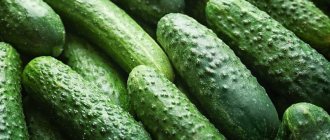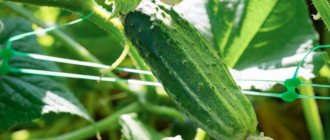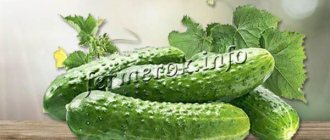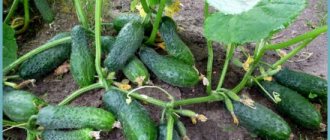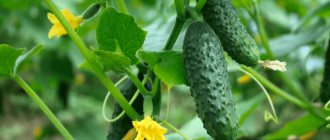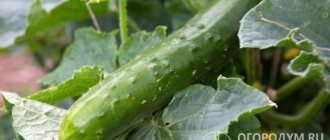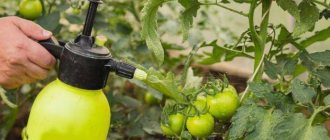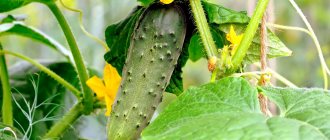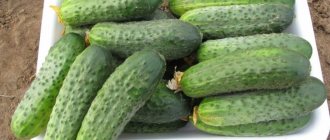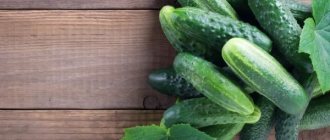Description of Trilogy F1 cucumbers
The Trilogy F1 cucumber variety is very young, it was bred by Dutch breeders (Rijk Zwaan Zaadteelt En Zaadhandel BV). It was added to the State Register of the Russian Federation in 2011 for the Central and North-Western regions. It is a first generation hybrid, as indicated by the F1 formula, and belongs to self-pollinating (parthenocarpic) plants.
According to the ripening period, it is classified as a mid-early variety. From the moment the seeds are planted to the ripening of the first wave of fruits, no more than 60 days pass. With proper care you can get a high yield.
The plant is low-growing with medium branching, indeterminate with unlimited growth of the central trunk. Since the length of the trunk can reach more than 1.5 m, it needs a garter; trellises are used for this. Pinching is also necessary to stop growth.
The main feature of the plant of the Trilogy F1 variety is that only the main trunk produces fruits, while the side shoots are very weak and do not bear fruit.
Flowering is stable, since the plants are self-pollinating, only female flowers appear. The fruit ovaries are well developed; on average, 3-4 ovaries can appear in one leaf axil.
The fruits are cylindrical in shape with a dark green color. The skin has spots and short light stripes. The pubescence is medium, the surface is finely tuberculate, the spines are white. The average length of one cucumber is 10 cm, and the weight varies from 60 to 80 g. The diagonal is approximately 3-4 cm.
Gardeners' ratings
Cucumber of the Trilogy f1 variety has been supplied to Russia by the Dutch relatively recently, however, it is already appreciated by many of our compatriots. We invite you to read useful reviews about this variety.
Valentina Borisovna, Krasnodar region, Tikhoretsk: “I have been looking for good gherkins for a long time and found a description of the Trilogy hybrid on the Internet. It turned out to be very worthy, now I plant it every year. Early variety. The fruits are tasty, crispy, smooth. If they outgrow, there won't be any big ones. The only drawback is that the seeds are too expensive compared to others.”
Iraida Aleksandrovna, Yekaterinburg: “Last summer I tried to grow Trilogy for the first time. Planted it with seeds. The harvest was solid and friendly, but the fruiting period was short-lived. The taste is excellent, the skin is thin. Suitable for salting and marinating. Unfortunately, they cannot be stored for a long time.”
Galina Aleksandrovna, Oktyabrsky, Bashkortostan: “Trilogy was recommended to me by an experienced gardener I know. I planted it and was very happy, because growing it is a pleasure. The hybrid is excellent, unpretentious, very hardy. I didn’t get late blight, unlike the variety that grew next door. I was pleased with the taste - quite juicy and crispy. I recommend it to anyone looking for tasty and high-quality gherkins.”
So, the characteristics of Trilogy and opinions about it allow us to conclude that this hybrid is undoubtedly worthy of the attention of gardeners who want to find a high-quality court of gherkins.
Taste qualities of cucumbers
Trilogy F1 cucumbers, according to many reviews, have excellent taste.
Attention! Trilogy F1 cucumbers are mainly harvested in the gherkin state; it is not recommended to grow the fruits until they are fully ripe.
In the gherkin state, Trilogy cucumbers have crispy and moderately juicy flesh, no bitterness. The skin is medium thick without much flavor. The taste and aroma of the fruit fully meet all the requirements related to cucumbers.
The harvest is universal due to its good taste. The fruits are consumed fresh, used for preparing cold appetizers, and they also tolerate canning and pickling well. Due to the average thickness of the skin, cucumbers are quickly soaked in brine, so when salted and pickled, they turn out crispy.
Video
You can also watch a video where an experienced gardener will tell you how hybrid varieties of cucumbers grow in a greenhouse.
So, Trilogy f1 cucumber is recommended to be grown spread out both in greenhouses and in open ground. The crop is characterized by high productivity and stress resistance. The fruits have an excellent appearance, excellent taste, and are excellent for both preparing salads and canning. The small size allows this cucumber to be called a gherkin.
Sources:
https://dachamechty.ru/ogurtsy/trilodzhi.html https://agronom.expert/posadka/ogorod/tykvennye/ogurets/trilodzhi-f1.html https://prodachnika.com/ovoshi/ogurtsy/trilodzhi.html
Pros and cons of the Trilogy cucumber variety
Trilogy cucumbers, according to the description of the variety and photo of the harvested crop, have significant advantages, which are as follows:
- early ripening;
- high productivity;
- uniform ripening and uniformity of fruits;
- resistance to various diseases;
- resistance to temperature changes;
- long shelf life of fresh crops;
- tolerates long-term transportation well.
Among the disadvantages, it should be noted only that this variety is not resistant to a disease called downy mildew. If the bush has been infected, it literally withers and dies within a few days. The plant has absolutely no immunity to this disease.
Care
How to properly care for Trilogy:
- Before the flowering period begins, cucumbers are watered infrequently, using only warm water. Watering with cold water will slow down growth. From the beginning of flowering and beyond, water the plants every day, moderately, in the morning or evening;
- Since cucumbers have a weak root system, it is advisable to use easily soluble fertilizers. The dosage is calculated taking into account the type of soil. During the entire growing season, 5-6 feedings are carried out. Be sure to alternate mineral and organic fertilizers, this will prevent excess amounts of the same nutrients in the soil;
- In the intervals between waterings, loosen the top soil layer;
- Provides the main crop to the central stem. For this reason, it is necessary to remove all lateral stepsons up to the horizontal trellis, leaving only the ovaries. At a height of 40-50 cm from the surface of the ground, not only the side shoots, but also the ovaries are blinding. When the central stem reaches the trellis, it is carefully wrapped around it and pinched after 50-100 cm, without touching 2-3 side shoots at the nodes in this interval. Next, the remaining shoots of the 1st and 2nd order after the 4th leaf are pinched;
- In greenhouse structures, greens are collected every day, from open beds - every other day.
Optimal conditions for growing Trilogy cucumbers
Trilogy F1 cucumbers can be grown by seedlings and by sowing seeds. The plant takes root well both in open ground and in greenhouse shelters.
When growing outdoors, you must choose a sunny place, protected from the wind. The soil should be sandy loam or light loamy, the optimal soil temperature is 15-17 degrees.
An excellent place for growing cucumbers of this variety is the land where onions, carrots, cabbage, peppers, tomatoes or wheat previously grew. But it is not advisable to plant cucumbers after pumpkin crops, because the yield will be very low.
Important! Trilogy F1 cucumbers should not be planted near bee-pollinated vegetable plant species.
Reviews
“Last summer I decided to try growing Trilogy F1 cucumbers. I planted seedlings. I used a trellis when growing. The harvest was good, but the bushes did not bear fruit for long. Zelentsy are very tasty with thin skin. I advise you to use the crop quickly, as cucumbers lose quality during storage.” Marianna, 48 years old.
“I am a gardener with little experience. I decided to experiment - I planted Trilogy seeds from Holland on one bed, and on the other, seeds collected last year from cucumbers of this variety grown in my garden. The difference between the resulting harvest is significant. The purchased seeds had better germination, the bushes were strong, the leaves were rich in color, the fruits were of good shape and taste. Not all of my planted seeds sprouted. The bushes were weaker, with thin vines. They had fewer ovaries, and many cucumbers were irregular in shape.” Stanislav, 37 years old.
Agricultural technology of Trilogy F1 cucumbers
Growing cucumbers of the Trilogy F1 variety is practically no different from growing other varieties of this vegetable crop. But there are still some nuances during planting and subsequent care.
Planting seedlings
If seeds are sown in open ground, they should be deepened by 6-8 cm. And when growing seedlings, seedlings should not be pricked, as they are very tender and do not take root well after transplanting.
Attention! Since picking seedlings is not required, the seeds should be planted immediately in peat cups.
Planting seeds for seedlings should be done 3-4 weeks before the expected date of planting in the garden. Typically this period occurs at the beginning of May.
Before planting the seeds, they are pre-soaked in warm water, and after they begin to hatch, they should be transplanted into separate peat cups with prepared fertile soil. Seedlings need to be watered in moderation.
Landing in the ground
Planting seedlings in open ground must be done when 2-3 full-fledged leaves have appeared. The seedlings should not be allowed to overgrow, since the Trilogy F1 variety does not tolerate replanting well, and with a long stem, it may be damaged, which will lead to the death of the plant.
The time of planting in the soil should be chosen at the moment it warms up to a depth of 4-5 cm to 12-15 degrees. In this case, the seedling will adapt to rising temperatures as it grows. Cucumbers should be planted in open ground in 2 rows according to the scheme - 6 seedlings per 1 sq. m. In greenhouse conditions, planting is carried out according to a single-row scheme at the rate of 3 seedlings per 1 sq. m. m.
Watering and fertilizing
Seedlings should be watered in moderation as they grow. It is worth noting that before flowering, Trilogy F1 cucumbers need a minimal amount of liquid. After the ovaries form, you should water them daily with warm water at the root. The recommended time for watering is morning or evening, when the garden bed is not exposed to direct sunlight.
When fertilizing, only easily soluble fertilizers should be used, since the root system of cucumbers of the Trilogy F1 variety is underdeveloped.
The amount of fertilizing is calculated based on how nutritious the soil is. Usually, cucumbers are fed 5-6 times during the season. Be sure to alternate fertilizers (organic and mineral).
Between waterings and at the time of fertilizing, the top layer of soil should be loosened.
Formation
The formation of the bush must be carried out when it reaches a height of 40-50 cm. Before reaching this length, all lateral stepsons and ovaries must be removed. When the main trunk reaches 80-100 cm, it is pinched and carefully wrapped around a support (trellis). In this case, at least 3 shoots must already be formed.
When 5 leaves appear on the shoots, they are also pinched. The number of ovaries is adjusted as the fruit develops and grows.
Protection from diseases and pests
This variety of cucumbers is very resistant to various diseases, except for downy mildew. To protect the plant and crop from diseases, it is not recommended to plant cucumbers in the same place. Re-planting is permissible no earlier than 3-5 years.
A preventative measure to protect against diseases is to spray the bushes with fungicide at least 2 times per season.
The most dangerous pest for this variety is the spider mite; the biological product “Actofin” can be used against it. Aphids and thrips can also cause damage. The drugs Actellik and Talstar cope well with them.
Productivity
In open ground, harvesting is done every other day, and in greenhouse conditions - daily.
According to photos, reviews and descriptions of many gardeners, Trilogy F1 cucumbers produce the maximum yield in the first month of fruiting. At this time, the yield of marketable fruits per hectare can vary from 330 to 650 centners.
Landing
To obtain an early harvest, seedling cultivation is recommended. But in the southern regions and warm countries, cucumbers can be sown directly into the ground when its temperature is +14-16 degrees.
Planting seedlings is needed 25-30 days before transferring them to the garden bed. It is not worth sowing earlier, as overgrown seedlings take root less easily.
The seeds do not require soaking or processing. 1-2 seeds are placed in individual peat pots with a nutrient substrate. It can be purchased at the store or prepared from the following ingredients:
- 1 share of turf soil;
- 1 share of peat;
- 2 shares of humus;
- 0.5 or 1 share of drainage - sand, sawdust or vermiculite.
The planted seeds are moistened and kept in a warm place until the sprouts hatch. Then provide the room with about +18-20 degrees of heat and daylight hours of at least 10 hours.
The bed is chosen in a sunny place where potatoes, peppers, tomatoes, cabbage, corn, onions or legumes were grown before cucumbers. Pumpkin and melons are unsuitable predecessors; they deprive the soil of the substances needed by cucumbers and can leave pathogens of specific diseases there. The site preparation is as follows:
- Dig the ground deeply.
- For every square meter, place a bucket of humus or compost and a glass of wood ash into the soil.
- In a greenhouse, remove the top 7-15 cm of soil and replace with fresh soil.
- Also in the greenhouse you need to disinfect the soil and all surfaces with a solution of potassium permanganate.
- Measure the acidity, and if the pH is above 6-7, then add dolomite flour.
Features of harvesting and storage
Since Trilogy F1 cucumbers ripen almost simultaneously, it is recommended to harvest every other day.
The requirements for long-term storage of vegetables are as follows:
- It is best to keep the fruits in a cool, dry basement at a temperature of +4...0°C, so they can be stored for up to 28 days;
- avoid temperature changes;
- select fruits that are fresh, whole, without damage or signs of rotting;
- put the cucumbers in boxes and sprinkle with sand.
